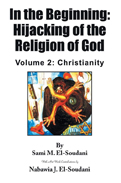
 |
In the Beginning: Hijacking of the Religion of God: Volume 2: Christianity
by Sami M. El-Soudani
Westwood Books Publishing
According to the author, the first hijacking of Christianity was done by Paul of Tarsus. His teaching that Jesus was the Son of God caused a rift between Paul (of those who saw a risen Christ) and Barnabas (of those who knew Jesus while on earth and considered him a prophet of God). Burton L. Mack, a former professor of early Christianity at the Clairmont Colleges in California, is one of the author’s key resources for the first hijacking argument. Mack traced theological movements among early Christians until the Pauline Christ myth was accepted.
El-Soudani quotes other sources for events of the birth and death of Jesus of Nazareth. His mother Mary’s annunciation per the Qur’an contains elements similar to the Genesis version of Hagar and Ishmael’s banishment by Abraham’s wife, Sarah, after the birth of her son, Isaac. The Gospel of Barnabas is quoted regarding Jesus’ birth and his final hours on earth. This gospel describes the deception of Jesus’ disciples, causing them to miss that Judas Iscariot was crucified instead of Jesus, and that it was his body stolen from the grave. The author points out that this was a non-digital age where people could be confused for someone else. After experiencing a natural death, Jesus reappears on earth to console his mother and disciples before returning to heaven. The epilogue sites other missing documents that would potentially explain Jesus’ aborted mission on earth.
The second hijacking, regarding the Trinity, is linked to the last days of Emperor Constantine. Using historical data from Karen Armstrong’s works, El-Soudani defines the times during which Greek theological debates disputed the creation and Logos/Christ myths. Before his death, Emperor Constantine convened three hundred bishops at Nicaea to resolve differences regarding a doctrine on the Trinity. They adopted the Roman Sun God (Christmas) celebrations and acquiesced to acceptance of a creed which is still repeated in some churches.
El-Soudani’s arguments regarding the hijacking of Christianity are well laid out based on information provided by his key resources. A successful argument must show respect, as the author has done here, for the stances of other people. A well-made case also demonstrates that human beings are able to philosophize about life while understanding the views of another person. Explaining a philosophy requires patience from both the author and those reading or listening. This is clearly demonstrated by the need for this comprehensive, three-volume set presenting the author’s religious convictions. His arguments are further assisted by his daughter’s flow charts, which serve as informative vertical timelines for early Christian history.
The author’s novel use of mathematical reasoning to prove truth or falsehood will likely appeal to those of a scientific bent. Readers who know little about Christianity will learn details that may cause them to wonder how Christianity gathered momentum and gained as much acceptance as seen today. Others, familiar with Christianity as taught by passionate church elders, may question whether there hasn’t been a more recent hijacking due to seminaries dissecting established religious documents based on newest archaeology finds, timelines, and translations. This book presents an engaging philosophical argument.
RECOMMENDED by the US Review